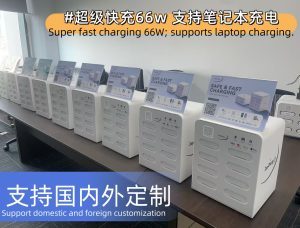Amid the global digital wave, shared power banks have emerged as a prime example of the “Chinese model going global,” experiencing explosive growth in overseas markets. This sector not only leverages China’s proven success but also relies on the mature ecosystem of its supply chain—particularly Shenzhen’s manufacturing base—to deliver efficient solutions worldwide.

I. Overseas Market: Golden Opportunities in the Dividend Phase
The penetration rate of shared power banks in overseas markets is less than 5%, equivalent to China’s early stage in 2017. Regions like Europe, North America, Southeast Asia, and the Middle East are witnessing surging demand due to accelerated 5G infrastructure, tourism recovery (Southeast Asia receives over 120 million tourists annually), and a young demographic dividend (50% under age 25 in the Middle East), creating a low-competition, high-growth blue ocean market.
China’s business model has proven profitability: in 2024, its shared power bank market exceeded ¥12.6 billion, with top players achieving monthly profits of ¥200–500 per unit via a “rental + advertising + data services” model. This core logic—high-frequency demand, scenario penetration, and efficient operations—applies equally overseas, with even higher pricing (e.g., ¥14/hour in Dubai).
II. Shenzhen: The Core Engine of Global Supply Chains
Over 90% of overseas shared power bank hardware is produced in Shenzhen. Dubbed the “Global Electronics Capital,” the city dominates due to three advantages:
- Full Industry Chain Cluster: From battery cells (e.g., EVE Energy) to fast-charging modules and IoT tech, Shenzhen offers end-to-end R&D and mass production, enabling rapid customization.
- Tech Iteration Efficiency: Manufacturers like Baofeng Charging can deliver prototypes within 7 days, supporting 200+ customization options (e.g., multilingual interfaces, religious adaptations).
- Cost Leadership: Direct factory supply reduces device costs by 30% compared to OEM models, lowering entry barriers for global clients.
III. Five Critical Capabilities for Selecting Manufacturers
Overseas complexity demands comprehensive localization—hardware alone is insufficient. Success hinges on:
- Integrated R&D for Hardware-Software: Companies like Baofeng Charging deploy 100+ R&D teams for variable-capacity fast charging (22.5W–100W) and bidirectional cabinet charging, achieving 1.8× higher device utilization than industry averages.
- Payment Ecosystem Integration: Must support local payment methods—e.g., credit cards (Visa/Mastercard) in the West, e-wallets (Momo, PromptPay) in Southeast Asia, and regional cards (Saudi MADA). Top manufacturers integrate 100+ payment gateways, ensuring 95%+ transaction success.
- Global Connectivity & Compliance: Devices require multi-band 4G/5G modules (covering 145 countries) and certifications like CE, FCC, and UN38.3; systems must comply with EU GDPR and Middle Eastern anti-money laundering laws to avoid risks.
- Localized Operations Experience: Manufacturers with overseas cases (e.g., Zhuma Technology in 30+ countries) offer scenario-based solutions like high-temperature casings (45°C tolerance) for the Middle East or freeze-resistant batteries for Nordic regions.
- Long-Term Technical & Operational Support: Requires local repair centers (<24-hour response), modular designs cutting maintenance costs by 60%, and multilingual support with dynamic pricing strategies.
Conclusion
The globalization of shared power banks has entered the “global operations” era, shifting its core competitiveness from hardware to full-chain capabilities in “technology + ecosystem + service.” Shenzhen manufacturers, leveraging industrial clusters and innovation, are pivotal to unlocking overseas billion-dollar markets. Moving forward, only those mastering both hard technology and soft power will build sustainable global barriers in this blue ocean.
